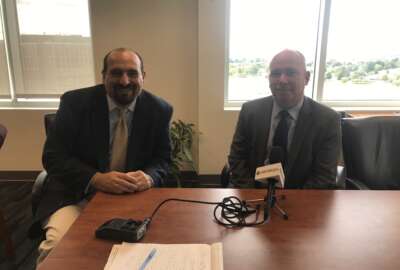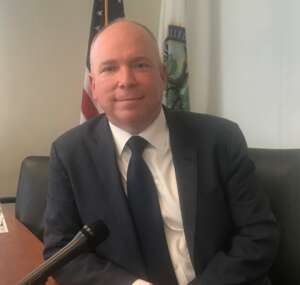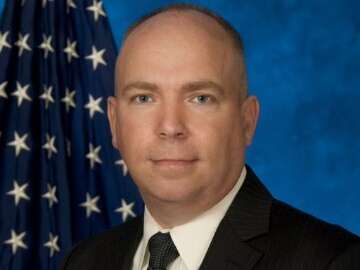
With foundation set, Education moves into phase 2 of IT modernization journey
Jason Gray, the Education Department’s chief information officer, said fixing long-standing problems like laptops that took 20-to-40 minutes to boot up and log in...
Best listening experience is on Chrome, Firefox or Safari. Subscribe to Federal Drive’s daily audio interviews on Apple Podcasts or PodcastOne.
The Education Department’s theme for year two of its IT modernization journey is consolidation.
The theme emerged only because year one successfully fixed long-standing infrastructure and basic technology issues.
Jason Gray, the Education Department’s chief information officer, said year two of this 5-to-8 year strategy is just the start of delivering better services at lower costs.

“We are looking at doing web consolidation. We are looking at doing cloud consolidation. We are looking at automating manual processes to reduce errors and improve efficiency,” Gray said on Ask the CIO. “The journey that we’ve had from January [2019] to May is like renovating a house, where you are removing all the electrical, all the plumbing and gutting the house. Now imagine doing that for a community of homes, and then imagine doing that across the nation where you have 11 different areas that you are doing these community of homes with thousands of users while the people are still living in those homes. That is literally what we’ve done, meaning all of this modernization effort, all of this transition from application and data standpoints has been done while the users have still needed to use those hardware and software.”
Gray — who has been Education’s CIO since 2016, making him now one of the longest serving technology executives — started this IT modernization journey with a focus on technology and process changes.
He spent the first few years fixing basic technology needs like getting employees new laptops that didn’t take 20-to-40 minutes to boot up and log in. He addressed governance issues so the mission and business customers his office serves have confidence and input into the technology that Education relies on.
“We have modernized our entire IT infrastructure whether it’s from a hosting environment or network environment or endpoint environment. We have transitioned and modernized all IT services that we provide here,” he said. “In January [2019] we started with our printer footprint by close to 56%, which changed the way people printed so that people could print to the cloud. If I’m here in D.C. and I’m on a regional visit in San Francisco I can retrieve that. It also helped us avoid unnecessary printing, over 1.5 million print jobs that haven’t printed that saves on paper, toner and wear and tear on the printer.”
Education also transitioned over 450 terabytes of data to a new hosting environment, saving $2 million. And with those laptops, now employees can log in to the network in less than a minute, have more memory and went to solid-state drives from disk drives, which also improved performance.
No more Windows 7 or Office 2010
All of those core modernization efforts came to fruition in 2019, but took several years to get to the point of transition.
But now that much of the basic infrastructure, which also included transitioning to Windows 10 from Windows 7 and to Office 365 from Office 2010, has been updated, Gray said he can focus on the next-level-down changes.
“In terms of the future in continuing our modernization effort, we are looking at ways we can rationalize from a systems and software portfolio standpoint,” he said. “We are 100% cloud, but I want to reduce the amount of cloud we have, not necessarily from a cost per gigabyte because it’s relatively the same, but the administrative overhead is where I’m looking at so we don’t have to have as many contracting officer representatives or project managers.”
Education has 25 different cloud service providers and Gray would like to take that number down to a smaller number.
“We did an inventory to make sure we understood how much cloud we have. Anything we can move internal, if it makes sense in terms of cheaper, faster or more secure,” Gray said. “It’s not about doing a bunch of contract modifications, but it’s taking a deliberate approach to where it makes sense to transition.”
Gray said the cloud sprawl has come under control over the last few years because he put out a memo requiring Education offices to come through the CIO’s office for new cloud instances.
Can’t just wave FITARA
While Gray could easily point to the Federal IT Acquisition Reform Act (FITARA) as a reason for the mission areas to get in line, but he realized soon after becoming CIO that memos and waving laws only can go so far.
“Our customers need to understand that it’s not just a law that says we have to do this, but what is the value. The value is speed. We get to deliver faster. The value is cost because we make sure the cost for providing the service is the least amount to the department to provide a minimal viable product,” he said.
This approach seems to be working well as Education was one of three agencies to receive an “A” grade on the latest FITARA scorecard.
As far as website consolidation, the goal is to move them into a smaller number of hosting environments.
“The goal behind that is two-fold. One is the administrative overhead of managing all of that. It’s also to reduce our footprint,” Gray said. “From a security standpoint, if we have 200 websites that fall within five cloud service providers versus 25 cloud service providers, we have a small footprint to manage and secure. The focus is to get down to a much smaller number than 25 just to reduce footprint and threat vectors.”
He added another key piece to the modernization effort is a reconfigured customer relationship management program to ensure the voice of the mission and business areas are included in the technology initiatives.
Copyright © 2025 Federal News Network. All rights reserved. This website is not intended for users located within the European Economic Area.
Jason Miller is executive editor of Federal News Network and directs news coverage on the people, policy and programs of the federal government.
Follow @jmillerWFED






